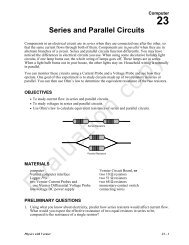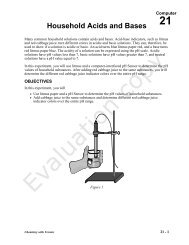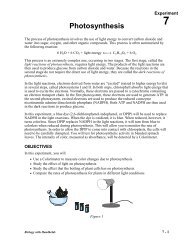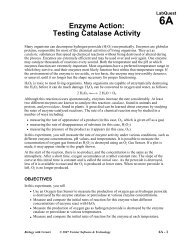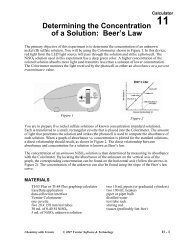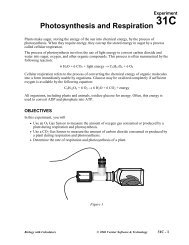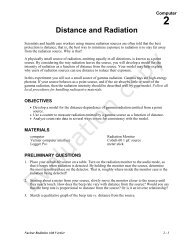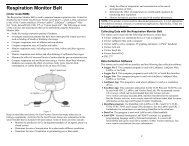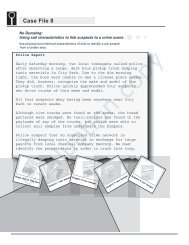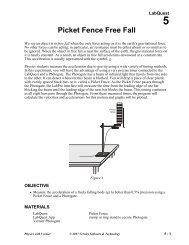Activities for the Wireless Dynamics Sensor System - Vernier ...
Activities for the Wireless Dynamics Sensor System - Vernier ...
Activities for the Wireless Dynamics Sensor System - Vernier ...
Create successful ePaper yourself
Turn your PDF publications into a flip-book with our unique Google optimized e-Paper software.
<strong>Activities</strong> <strong>for</strong> <strong>the</strong> <strong>Wireless</strong> <strong>Dynamics</strong> <strong>Sensor</strong> <strong>System</strong>TEACHER INFORMATIONInvestigating Collisions with CrumpleZones1. Most students will know that cars have crumple zones, air bags and seat belts to aid<strong>the</strong> protection of people in collisions. They might not realize that crumple zones havealso been developed <strong>for</strong> use on trains. The crumple zones also help to keep a train on<strong>the</strong> track following a collision.2. When discussing <strong>the</strong> accelerometer reading, it is proper to refer to it as a measure ofNormal Force per Unit Mass, with units of N/kg, where “normal” is in <strong>the</strong> directionof that particular accelerometer. This is what <strong>the</strong> accelerometer is actually measuring.(Note that it is not <strong>the</strong> net <strong>for</strong>ce per unit mass which would be acceleration.) Amotionless accelerometer oriented in <strong>the</strong> vertical direction will give a reading of+9.8 N/kg when pointed up and -9.8 N/kg when pointed down. A motionlessaccelerometer oriented in <strong>the</strong> horizontal direction will read 0 N/kg. An accelerometerin freefall will give a value of 0 N/kg regardless of its orientation. Since most peopleprefer <strong>the</strong> measurement be in m/s 2 , we have used <strong>the</strong>se units in this manual.3. To prevent damaging your WDSS, be sure to keep it on <strong>the</strong> dynamics track.4. WDSS acceleration readings greater than ±50 m/s 2 are not reliable as <strong>the</strong>y exceed <strong>the</strong>maximum measurable acceleration of <strong>the</strong> WDSS. These accelerations result when <strong>the</strong>cart hits <strong>the</strong> end stop.5. The following web sites contain in<strong>for</strong>mation on collisions with crumple zones.• Finite Element Analysis – this Wikipedia web site provides a very brief explanationof what FEA is and where and how it is used, plus a number of useful externallinks.http://en.wikipedia.org/wiki/Finite_element_analysis• Introduction to Finite Element Analysis – this site provides a simple and briefintroduction to FEA, its history, what it is, how it works and where it is often used.http://www.sv.vt.edu/classes/MSE2094_NoteBook/97ClassProj/num/widas/history.html• Modeling collisions of rail vehicles with de<strong>for</strong>mable objects – this detailed reportwas produced by AEA Technology Rail <strong>for</strong> <strong>the</strong> Rail Safety and Standards Board of<strong>the</strong> UK. The report contains many images showing <strong>the</strong> stages of such simulatedcollisions toge<strong>the</strong>r with associated graphs looking at <strong>the</strong> velocity and energyprofiles of <strong>the</strong> colliding objects.http://www.rssb.co.uk/pdf/reports/research/T305%20Modelling%20collisions%20of%20rail%20vehicles%20with%20de<strong>for</strong>mable%20objects.pdf• Volpe Center Highlights – this article looks includes in<strong>for</strong>mation about a crash testof railway cars colliding with a concrete wall at 26 mph. The web site is <strong>for</strong> <strong>the</strong>research and development centre in Cambridge, Massachusetts, USA <strong>for</strong> nationaltransportation systems.http://www.volpe.dot.gov/ufosrc/highlts/pdf/400.pdf© 2007 - <strong>Vernier</strong> Software & Technology 43




